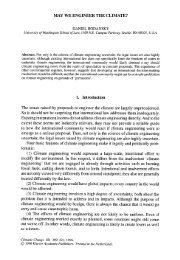ThorEA - Towards an Alternative Nuclear Future.pdf
ThorEA - Towards an Alternative Nuclear Future.pdf
ThorEA - Towards an Alternative Nuclear Future.pdf
You also want an ePaper? Increase the reach of your titles
YUMPU automatically turns print PDFs into web optimized ePapers that Google loves.
4.6 <strong>Future</strong> opportunities facilitated by ADSR<br />
accelerator research<br />
Typical engineering patents in the area highlighted in<br />
the section 4.2 bear a close resembl<strong>an</strong>ce to technologies<br />
currently in the patent portfolio held by STFC’s world leading<br />
accelerator science facilities. This patent portfolio has been<br />
largely developed through the design build <strong>an</strong>d use of the<br />
Daresbury Laboratories Synchrotron Radiation Source <strong>an</strong>d<br />
the ISIS facility at Rutherford Appleton Laboratory. For<br />
example, STFC are currently filing a patent on <strong>an</strong> invention<br />
describing <strong>an</strong> asymmetrical magnet solution as a direct result<br />
of the current ns-FFAG.<br />
IP generation is expected to be in fields that are both relev<strong>an</strong>t<br />
historically to existing accelerator technologies <strong>an</strong>d looking<br />
forward to the thorium-fuelled ADSR project they include<br />
adv<strong>an</strong>cements in cryogenics, magnet configurations, vacuum<br />
technologies, detectors, <strong>an</strong>d imaging devices, laser related<br />
technologies, amplifiers, tr<strong>an</strong>sducers <strong>an</strong>d proton beam<br />
generation, delivery, spallation, <strong>an</strong>d spallation targets. These<br />
<strong>an</strong>d other new areas to be explored include tr<strong>an</strong>smutation of<br />
waste, energy production, hydrogen production, pyrolysis.<br />
These latter, less explored technologies, are outlined more<br />
specifically in the next section.<br />
Figure 12. The CONFORM project’s EMMA: the world’s first nonscaling<br />
fixed field alternating gradient (ns-FFAG) accelerator,<br />
currently under construction at Daresbury Laboratory<br />
The degree of inventiveness associated directly with<br />
CONFORM’s accelerator development programme is<br />
enormous. A prototype of the world’s first ns-FFAG, “EMMA”,<br />
(Figure 12) is currently being assembled at the Daresbury<br />
Laboratory as a key component of the CONFORM project<br />
m<strong>an</strong>aged in part by authors of this report. The conceptual<br />
designs for CONFORMS’s PAMELA – the next ns-FFAG that may<br />
be built at Daresbury – has been designed to have a small<br />
footprint. PAMELA will provide the basis for the development<br />
of ADSR proton drivers: it will be particularly suitable for<br />
both a cellular approach to power generation using multiple<br />
accelerators, <strong>an</strong>d for its use in clinical applications based<br />
in hospitals where l<strong>an</strong>d space is at a premium. PAMELA,<br />
presently a conceptual physics design <strong>an</strong>d about to progress<br />
to the engineering feasibility phase, demonstrates the<br />
synergies of the ADSR programme with other adv<strong>an</strong>ced <strong>an</strong>d<br />
diverse technologies.<br />
The design <strong>an</strong>d construction of CONFORM’s PAMELA is expected<br />
to generate fundamental IP as well as regenerating existing<br />
STFC IP. PAMELA’s novel configuration (two concentric<br />
accelerator rings with dual injection <strong>an</strong>d extraction) is set<br />
to generate a supply of novel designs in equipment <strong>an</strong>d<br />
technologies. Areas of particular relev<strong>an</strong>ce include super<br />
conducting magnets, cryogenic technologies, <strong>an</strong>d third<br />
harmonic cavities, new materials, specialist coatings <strong>an</strong>d<br />
LINAC designs. It is expected that IP will be in the form of<br />
patents, knowhow <strong>an</strong>d drawings.<br />
Taking adv<strong>an</strong>ced particle accelerators from the physics<br />
laboratory to real world routine industrial applications is a<br />
signific<strong>an</strong>t challenge. Meeting this challenge will generate<br />
m<strong>an</strong>y inventions. Individual components will have to be<br />
robust with in-built reliability <strong>an</strong>d it must be possible to track<br />
<strong>an</strong>d replace failing components with minimum disruption.<br />
Design for bulk m<strong>an</strong>ufacture of “off-the-shelf” high power<br />
accelerators for exportable ADSR systems will also create a<br />
rich source of IP <strong>an</strong>d keep existing IP in the projects portfolio<br />
alive through regeneration.<br />
A report prepared by: the thorium energy amplifier association 35



